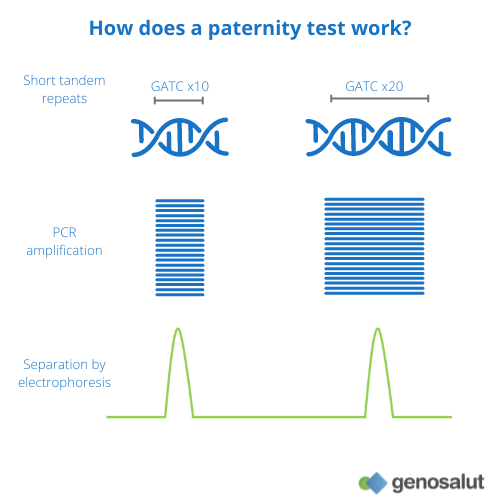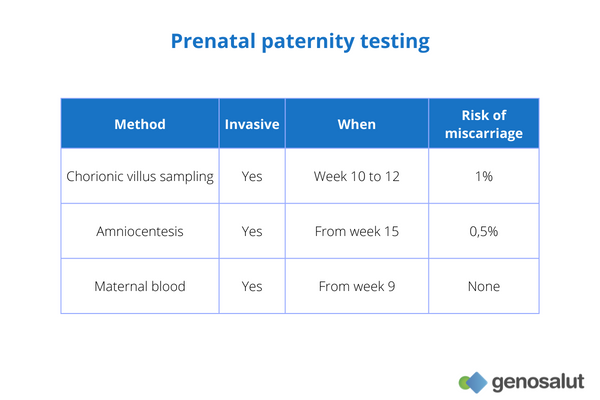The paternity test aims to determine the biological relationship between two people. In other words, it allows us to determine who is the biological father or mother of a child. An extension of this type of analysis is kinship testing, which allows us to determine other types of family relationship: siblings, grandparents, aunts, uncles, cousins, etc.
A paternity test can bring clarity not only to doubting fathers, but also to women who are not sure whose child they are expecting.
Find out here how a paternity test is carried out, what a paternity test can cost, how reliable the result is and what you need to know about the legal regulations.

How does a paternity test work?
Paternity and kinship tests consist of an analysis of the DNA of each individual to obtain the so-called genetic profile or genetic fingerprint. By comparing the genetic profiles obtained from two individuals, the relationship between them can be determined.
We inherit half of our genetic material from our father and half from our mother. In our DNA we find coding regions, the genes, which account for only 2% of our entire genome, and non-coding regions. In these regions we find, among other things, sections full of repeats: short sequences of DNA bases that are always strung together in the same way. Paternity tests are based on the analysis of these repetitive regions of DNA.
Scientists refer to these repeats as short tandem repeats (STRs). STRs are made up of between two and seven DNA bases that can be repeated many times. The sequence “GATC”, for example, may appear eight times in one person, but fifteen times in another.
They are as individual as a fingerprint and allow people to be identified almost uniquely (with the exception of identical twins).
A paternity test is not a genetic test, because it provides little information about inherited genes. Instead, it determines the length of individual DNA segments, and in doing so reveals much about ancestry.
The analysis starts with the extraction of DNA from a sample (usually saliva). Because the amount of DNA obtained from these samples is very small, it is first necessary to amplify the DNA in order to be able to analyse it. To do this, scientists use the polymerase chain reaction (PCR): millions of copies of the STR sections can be produced in a few hours. The DNA copies are then bound to a fluorophore to make them visible in the next step.

STR segments differ in length and so do their PCR-generated copies. Therefore, the sample obtained after amplification is sent through a narrow mesh network in which the smaller copies move faster than the larger ones. In this so-called electrophoresis, the speed with which the DNA copies migrate can be used to infer their length.
In a paternity test, between 15 and 40 DNA markers are analysed. At the end of the analysis, scientists have a large number of measuring points, separately for the father, the child and sometimes also the mother. However, this is not enough, the crucial step in a paternity test is the statistical evaluation of the data with special programmes.
What samples are needed for a paternity test?
All cells in the body contain DNA. Therefore, samples of blood, hair or saliva (containing the body’s own cells) are suitable for analysis.
For paternity testing, saliva samples are usually used, as blood is more difficult to obtain and hair cannot always be clearly assigned. A swab of the oral mucosa is sufficient to obtain the sample.
A paternity test requires at least two samples: one from the child and one from the possible father. Ideally, a sample from the mother should also be tested. The results make it possible to rule out paternity or classify it as highly probable.
How reliable is a paternity test?
Samples obtained from the child and the possible father are examined in the laboratory. The possible results are:
● Paternity ruled out: this is a result with 100% reliability.
● Practically proven paternity: with this result, the probability of paternity is 99.99% if the mother did not participate in the test. When a so-called trio case is tested, i.e. the mother gives her saliva sample together with that of the child and the possible father, probabilities of over 99.9999% are usually achieved.
In other words, a paternity test can only indicate probabilities, even if they are sometimes very high.
What types of paternity tests are there? Private and legal
In terms of their usefulness for legal purposes, paternity tests are classified as informative and legal.
Private paternity test
When it is intended to establish the biological link between two people for private and private use, whereby the participants are not asked to identify themselves, thus guaranteeing their anonymity. The information obtained cannot be used for legal proceedings.
Legal or court approved paternity test
A paternity test is done when it is intended to be used in a legal proceeding. For this reason, the requirements are more demanding: the persons tested must be identified and the identity of the samples must be guaranteed until the analysis and delivery of the results.

Can a paternity test be carried out before the birth of a child?
Yes, prenatal paternity testing can establish the biological relationship between an alleged father and his unborn child. Depending on how the samples are taken, it can be informative or legal, invasive or non-invasive.
This test resolves two types of doubts:
● That of the baby’s mother who is unsure who the father might be.
● That of the presumed father who doubts that he really is the father.
It has the advantage of making it possible to anticipate decision-making. But also certain disadvantages, which are: the risk to the baby if the invasive prenatal test is chosen, and a high price if the non-invasive test is chosen, as it uses sophisticated and complex technology.
Legal issues: Who can request a paternity test?
The answer depends on the type of paternity test to be performed. According to Spanish law, which is different from that of other European countries:
● Private paternity test: anyone can request it. In other words, the test can be carried out without the knowledge of either of the parties.
● Legally valid paternity test: If both persons are of legal age, it is assumed that they are aware of what they are doing and therefore give their express consent for the test to be carried out. If one of the persons is a minor, it is sufficient that one of the parents or a legal guardian consents to the test.
How much does a paternity test cost?
The cost of a paternity test in a private laboratory ranges from €200 to €700. Home or pharmacy tests usually cost between €150 and €250. For non-invasive prenatal paternity testing, the price can be as high as €1,700.
However, beware of suspiciously cheap products! They may belong to laboratories that do not comply with the necessary guarantees and quality controls or that are not subject to Spanish jurisdiction. The legal requirements of quality standards for the production of parentage reports differ considerably between countries and defective analyses cannot be challenged in Spanish courts.
At Genosalut we provide informative paternity tests, legally valid paternity tests and genetic fingerprinting.
If you like our blog, subscribe to our newsletter


